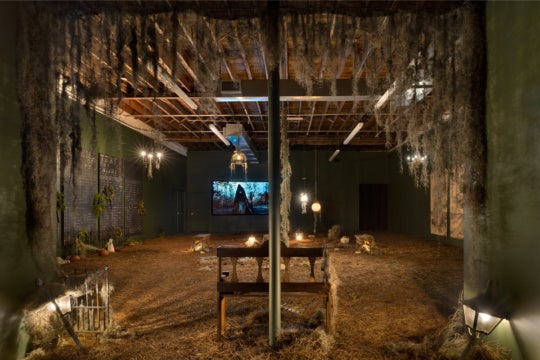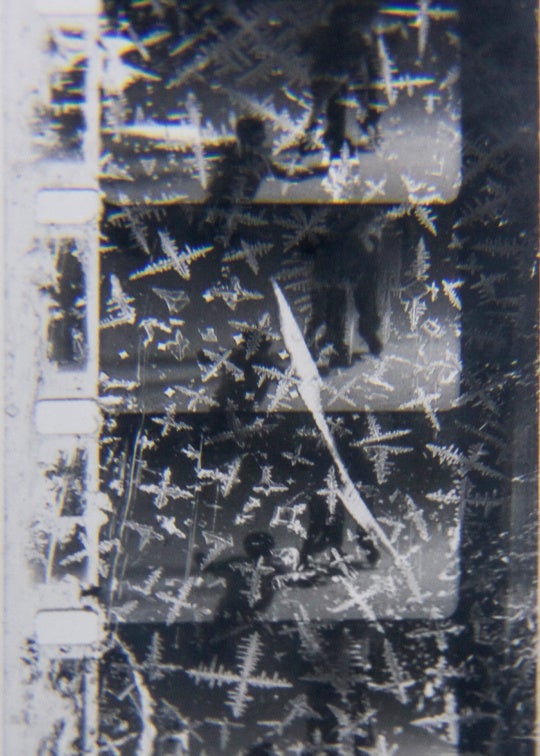
Emory professor and former Grady cancer director Dr. Otis Brawley’s book How We Do Harm: A Doctor Breaks Ranks About Being Sick in America is a lacerating, eye-opening look at the complex swirl of race, class, ethnicity, and trust or distrust that define our polarized view of the world. As a doctor serving a largely suspicious, impoverished African American community at Grady Hospital, Brawley is analytical and self-scrutinizing about what he, and the medical establishment as a whole, represents to his patients. He is also profoundly aware of the life experiences that brought his patients to him and how those experiences shape their vision of the world. His book is a rare glimpse, through the prism of the American health care system, at the complexity of race in daily life.
In the same way the City Gallery at Chastain exhibition Question Bridge: Black Males through March 17 is a profoundly revealing navel-gazing exercise in self- and community-analysis.

The focal point of the show is a three-hour collaborative video piece—also a selection of the 2012 Sundance Film Festival—by Chris Johnson, Hank Willis Thomas, Bayeté Ross Smith, and Kamal Sinclair in which a spectrum of African American men across age and class propose a question in a direct-address to the camera. Some of the men are well-known: including actors Jesse Williams and Delroy Lindo, rapper Killer Mike, and politician Andrew Young. Others are anonymous, but no less poignant and thoughtful in their questions and responses.
After a question is asked, it is then thrown out into a kind of digital universe: other screens pop up on the wall in which various men, also directly addressing the camera, respond to that query. The questions are practical, humorous, existential: How do you face the day each morning? How do you know she’s the one? Why are black men so reluctant to see the doctor? Who started this whole “what’s up man?” with which black strangers greet each other? The questions get at a sense of self-surveillance that affects various social Others—implicated is a reflex to explore the meaning and impact of experiences because one’s being is so consistently scrutinized and evaluated.
The revelations suggest the NPR StoryCorps concept, but with an element of collectivism. The men answering the questions do not know the man proposing the question, which gives a larger, humanistic quality to the project, as they seek to respond to, and perhaps help, a stranger based on their personal life experiences. The interactive question-and-answer format among strangers brings a spontaneity and truth-telling to the enterprise that gives the project its heart and soul.
Refusing the idea so often touted in popular culture that black men are some formless and autonomous mass, with shared characteristics and behaviors, Question Bridge instead proposes a multiplicity of both questions about what seems innate and given and an even greater array of responses. In tackling such large and small questions, this deeply insightful, emotionally layered video work penetrates the skin of public behavior, plumbing the depths of private lives. In just one example, a preppy-looking thirty-something man in a neat cardigan describes his brother’s maddening reluctance to see a doctor. A question that some of the men treat lightly has real impact for this man, who breaks down describing losing his brother to diagnosed-too-late cancer. “We think we’re so strong,” he laments. Equally moving is how these voices speak across decades of experience, suggesting a need for what happens too little in American society—including among black men—sharing wisdom and perspective. The art world is certainly flush with such plainspoken revelation: artists from Gillian Wearing to Hannah Wilke to Adrian Piper to Richard Billingham have tackled in various media, the human animal observed at its most fragile and revealing state. But the frankness and vulnerability expressed in the relatively straightforward Question Bridge format feels utterly fresh, making one realize how much black men have been superficially rendered in popular culture—how little, in essence, we truly know. “We are not monolithic,” says one of the participants, and his observation resounds throughout this group show.

The gallery is filled with the sounds of these men’s voices and their often intimate revelations. One small flaw, that can—at times—be a plus, is the video’s placement in the large, open gallery space. The voices of the men can become distorted when heard close up from the benches where you are invited to watch the piece, but they often register incredibly well when heard from far away, in corners of the gallery space. The Question Bridge video piece—really the focal point and heart of the show that tends to make the other work pale in comparison—follows you even as you take in other works in the exhibition. A perennially harrowing Hank Willis Thomas work from his B®ANDED take-down of advertising imagery, for instance, is a send up of the status-conscious Master Card ads. In Thomas’s Priceless image from the B®ANDED series, family members mourn at a graveside funeral. Text superimposed on the image catalogues the various “priceless” attributes: gold chain $400; 3-piece suite $250; 9mm pistol $90; picking the perfect casket for your son: priceless. Also included are a trio of Chris Johnson’s silver gelatin photographs treating various states of distress, entrapment, and loving celebration of the past to suggest the complexity of black experience for good and bad. A quote by W.E.B. DuBois from The Souls of Black Folk on the gallery wall amplifies that point, “The history of the American Negro is the history of this strife—this longing to attain self-conscious manhood, to merge his double self into a better and true self.”
Continuing the themes of Question Bridge and the complexity of identity, Bayeté Ross Smith’s photographs feature the same man in profile gazing upon his own twinned image. But in each photograph, the men assume different guises according to their dress and attitude. When seen in the context of Question Bridge, which digs beneath the surface of what black “means,” the image of a man wearing a sloppy nylon vest on one side of the image and his more stylish image in glasses, hipster hat, and gold necklace imply there are vast differences in how dress and manner can color our perceptions. The real flaw in this particular suite of images, however, is the bookending of this dual portrait of a black subject with portraits of Asian men. The combination dilutes the overall message of Question Bridge, focus of which is so relentlessly on African American identity.
The exhibition grew out of a project first launched by Chris Johnson in San Diego and became a collaborative piece linking Hank Willis Thomas, Bayeté Ross Smith, and Kamal Sinclair and is now composed of 1,500 questions and 150 men. The show’s tangential works can often seem less powerful than the Question Bridge video work, which harkens back to a time in the American art world when questions of identity, race and gender were at the fore. Question Bridge is the kind of superficially simple in scope, but intellectually complex, work that serves as a reminder of how urgent these issues remain.
Question Bridge: Black Males will remain at the Chastain Arts Center through Saturday, March 17, 2012. The gallery is open Monday through Friday from 9:30AM to 5PM and Saturdays from 10AM to 3PM.




